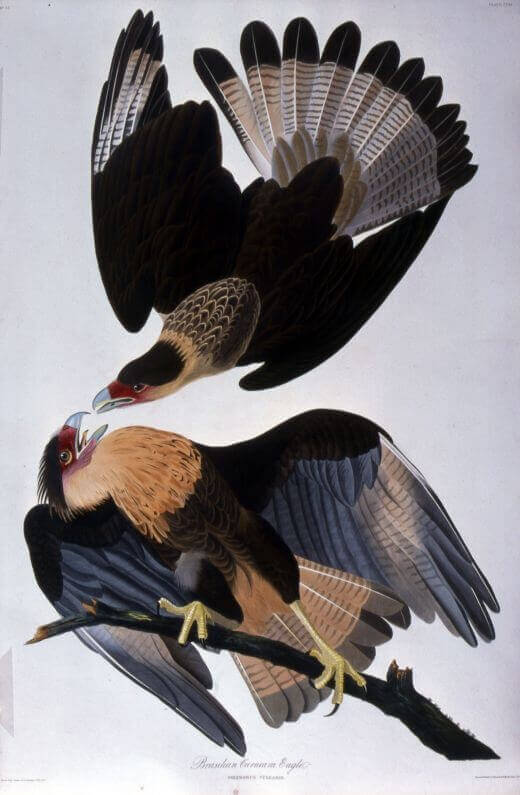The Complete Audubon: The Birds of America
Laura Randall

John James Audubon, CLXI (161), Brazilian Crested Caracara, from Birds of America, 1827–1838. Courtesy HistoryMiami
February 27–May 31, 2015
In a letter to his wife Lucy, John James Audubon described his first impression of Florida as “the poorest hole in Creation,” a disheartening observation in light of Audubon’s reputation as a spirited French-American of indefatigable passion. His achievements in identifying and documenting 435 bird species for Birds of America continues to reign supreme among the environmental, historical, and art-minded alike. For three months, HistoryMiami supplied visitors who share Audubon’s sentiments with a contemporary vision of his work. One hundred eighty-four years after Audubon traversed Florida’s east coast, the museum has mounted the entire original set of prints from Birds of America in the first exhibition of its kind.
Also referred to as the “Elephant folio” for its unwieldy 39 x 26–inch scale, each hand-painted copper print reveals the intense devotion Audubon maintained through-out the thirteen years spent hunting and documenting each breed for publication. Audubon’s concern for portraying accurately each bird’s true-to-life size, shape, and color was a painstaking duty to impart on his colorists. One can appreciate why this exhibition is truly monumental—conceivable only after the museum’s expansion into the galleries once occupied by the Miami Art Museum—upon close inspection of a single print.
Audubon’s frustrations in Florida occurred early upon his arrival in 1831, and are supremely illustrated in plate 161. The birds depicted in this plate mark the first of fifty-two new birds he would identify over the next several months in Florida. Opting to render two crested caracaras instead of one, Audubon shows off the striking marks across the bird’s tail and around his breast in a violent image. Audubon renders one of the raptors sweeping down the page in attack mode, highlighting the bird’s long neck, while the defending bird turns in profile, his long leg outstretched. The yellow-orange patches around the face mask the mess of flesh left from the bird’s last feed—a rotting horse—enjoyed shortly before its encounter with Audubon and his partner Henry Ward.
To speak nothing of the timeless regard for these images, the “Elephant folio” sets have always been elusive, with slightly fewer in number than actual crested caracaras in Florida today (about 250). The exhibition at HistoryMiami offers viewers a rare chance to inspect the exquisite detail of every print firsthand, all at once. Normally, when the prints are on display, the folios are viewed individually, still bound in special collections or in parcel sets on the wall. HistoryMiami presents a visually stunning archive documenting dozens of birds that once were—and hundreds that, currently, barely are—in the order they were first printed, in the salon-style hanging popular in Audubon’s time.
Perhaps it was Audubon’s patience as an observer of birds or his arrival to the Florida Keys that eventually inspired him to turn a new leaf in his own attitudes about the state. Regardless of how the change took place, he became uniquely equipped to discover Florida’s quiet beauty. Like our native species of plants and birds, the fleeting nature of the folios themselves requires hiding, but those of us fortunate enough to experience the true magnitude of these works through this exhibit, to celebrate their sheer diversity, may come to know what Audubon understood upon his arrival in St. Augustine: “I have ascertained that feathers lose their brilliancy almost as rapidly as flesh of skin itself, and am of the opinion that a bird alive is 75 percent more rich in colors than twenty four hours after its death.”










